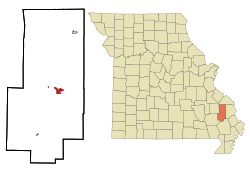Marble Hill, Missouri
| Marble Hill, Missouri | |
|---|---|
| City | |

Marble Hill City Hall, April 2014.
|
|
 Location of Marble Hill, Missouri |
|
| Coordinates: 37°18′18″N 89°58′35″W / 37.30500°N 89.97639°WCoordinates: 37°18′18″N 89°58′35″W / 37.30500°N 89.97639°W | |
| Country | United States |
| State | Missouri |
| County | Bollinger |
| Government | |
| • Type | Mayor-Council |
| • Mayor | Russell Masterson |
| Area | |
| • Total | 1.65 sq mi (4.27 km2) |
| • Land | 1.64 sq mi (4.25 km2) |
| • Water | 0.01 sq mi (0.03 km2) |
| Elevation | 489 ft (149 m) |
| Population (2010) | |
| • Total | 1,477 |
| • Estimate (2012) | 1,499 |
| • Density | 900.6/sq mi (347.7/km2) |
| Time zone | Central (CST) (UTC-6) |
| • Summer (DST) | CDT (UTC-5) |
| ZIP code | 63764 |
| Area code(s) | 573 |
| FIPS code | 29-45848 |
| GNIS feature ID | 0731613 |
Marble Hill is a fourth-class city in central Bollinger County in Southeast Missouri in the United States. Located at the intersection of State Highway 34 and State Highway 51, it is the largest city in Bollinger and serves as the county seat. The population was 1,477 at the 2010 census. The city was officially organized in July 1851 and is named after a marble-like rock.
Marble Hill is part of the Cape Girardeau−Jackson, MO-IL Metropolitan Statistical Area.
The area that would eventually become known as Marble Hill was established in 1842 as New California. Nine years later, it was renamed Dallas in 1851. As the area grew over the years, the First Baptist Church was built in 1856 near the oldest cemetery in Marble Hill. In 1862, the courthouse and town of Dallas was raided by Colonel S.D. Kitchen along with 120 Confederate soldiers. Finally, in 1868, the name of the town was changed again, this time to Marble Hill, to prevent confusion with the already existing Dallas County, Missouri.
A year after the name change, a man by the name of Eli Lutes laid out what would become known as Lutesville. Lutes offered 10 acres (40,000 m2) to the railroad for a depot location which would be used as a shipping and trading point. Disputes with leaders of Marble Hill persuaded the railroad to relocate their route through Lutesville instead.
In 1880, Will Mayfield College moved to Marble Hill from Smithville. It remained in operation there until its closing in 1934. In 1893, Wicecarver's Store was built across from the courthouse where the steps in front were formerly used for mounting horses and carriages. Between 1904-1905, the Mineral Well was dug on the courthouse square and was used until 1947-1948. The year 1932 marked the last passenger line on the Belmont Branch of the St. Louis & Iron Mountain Railroad. The railroad company ceased operations through Lutesville in 1973. In August 1953, an artesian well was discovered approximately 1,800 feet (550 m) deep while drilling for oil in the area. A few years later in 1973, voters approved a measure to build what would become known as Twin City Airport.
...
Wikipedia
